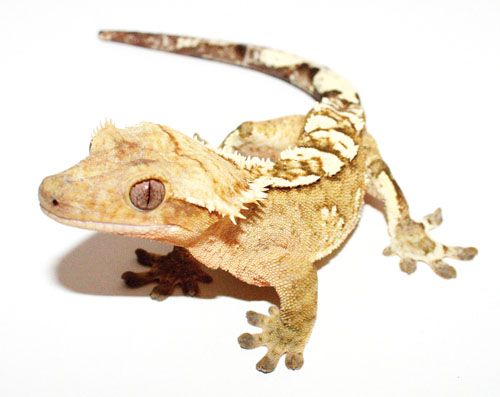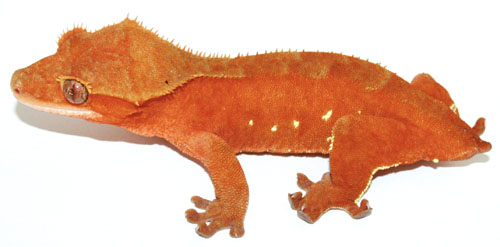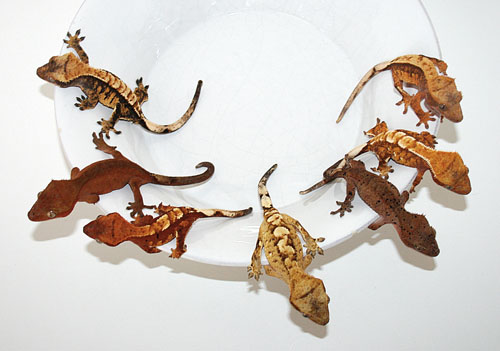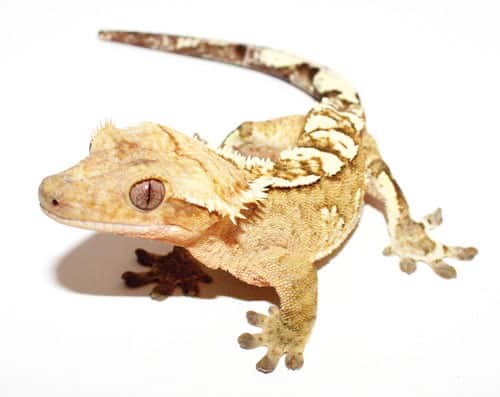A variety of crested gecko morphs are created every year.
The crested gecko (Rhacodactylus ciliatus) is one of the most hardy and attractive of all the captive-bred gecko species. Docile in nature, it has the ideal temperament for a first-time reptile pet. It is quiet, easy to care for, hypo-allergenic, affordable and doesn't take up a lot of space. Naturally polychromatic animals, these geckos have the ability to produce a wide range of patterns and colors. In fact, due to selective breeding, new pattern and color morphs are emerging yearly, making the crested gecko one of herpetoculture's most exciting breeding projects.

Photo credit: Kimberly Pomplun Lucas.
Mocha creme flame crested gecko.
An Unusual Appeal
The most identifying features of a crested gecko are its crested head and lashes, hence the common name. Although the crests look spiky and rough, the skin actually feels soft and leathery, similar to suede. Given that the crested gecko lacks eyelids, it is not unusual to see one cleaning its eyes with its tongue. As a form of eye protection, the gecko possesses a large scale called a brille, which is periodically shed with the rest of its skin. Crested gecko feet, as in other species such as tokay and day geckos, allow them to walk on smooth surfaces with ease, thanks to sticky toe pads covered with microscopic, hairlike structures called lamellae.
They reach sexual maturity within 18 months and are one of the easiest geckos to breed. Adults typically weigh 38 to 45 grams, growing to 8 to 10 inches in length, with a third of that being a prehensile tail. If threatened, they will drop their tails, but unlike most geckos, they will not regenerate them. Many wild crested geckos, and some of the prized geckos in my colony, no longer have tails. gecko can be as simple or complex as you choose. These hardy lizards are arboreal in nature, so the taller the enclosure, the better. I keep all my adults in tall, Plexiglas enclosures that have a screen top and front, and that measure 17 inches long, 16 inches wide and 23 inches tall. The screening allows enough ventilation while helping me maintain a humidity level of 80 percent for at least a couple hours a day. A shallow dish filled with filtered drinking water is also available. To reduce shed problems, I mist each enclosure thoroughly with a spray bottle at least once daily for adults and twice for juveniles and babies. Because crested geckos are nocturnal creatures, it is best to mist at night when they are up and about, giving them the opportunity to lap up the water as they would in nature. In the winter months, when air is dryer, it is helpful to provide them with a moist hide box. I use one that is 7 inches long, 4 inches wide and 4 inches tall, filled with moistened, but not drenched, sphagnum moss. The geckos will burrow into this when they require additional humidity.
For ease of cleaning, substrate can be as simple as paper towels or newsprint. Cypress bark mulch or orchid bark mixed with moistened coco fiber is also good for a more naturalistic look. Do not use cedar products, sand or anything that may be easily ingested. Such substrates are potentially harmful and can be deadly to your geckos.
Crested geckos are arboreal and love to climb and jump. I suggest hanging multiple vines and plants from the top of the enclosure. This allows them plenty of places to explore and in which to hide, reducing the inclination to hang upside down on the enclosure's sides, which may contribute to floppy-tail syndrome. This can happen when a gecko spends the majority of its time clinging upside-down to the ceiling or wall of an enclosure, allowing its tail to flop 90 degrees to the side or directly back. Extended periods of time in this position can deform the pelvis and lead to permanent damage to the pelvic girdle and spine. Adding vines and hanging plants will reduce the likelihood they your geckos will sleep on the sides of the enclosure.
Crested geckos do not require any ultraviolet lamps, basking spots or additional heating elements. In fact, they are more likely to become stressed and die from excessive heat than anything else. Their ideal temperature range is between 68 to 80 degrees Fahrenheit, and they can tolerate overnight lows in the 60s. For a good nighttime viewing light source that doesn't produce heat, I use small, red holiday lights bunched up on top of the enclosure. It is an attractive and safe option. You can also purchase special lighting for nocturnal geckos at your local pet store or via the Internet.
Morph Madness
The most exciting part of breeding crested geckos is the wide array of new colors and patterns, known as morphs, emerging every year. Super tiger, marbled, sorbet swirl, and this years' gem, the calico, are just to name a few. The wild-collected crested geckos can't even touch the colors and patterns now available through selective breeding. Even a novice breeder can invest in a couple of spectacular geckos and start producing the next hot gecko morph.
Omnivorous Diet
Crested geckos are omnivores, and in the wild, they eat a varied diet of insects, rotting fruits and nectars. In captivity, baby food was once a suggested diet; however, I do not advocate baby foods as a nutritional or affordable feeding option. Baby food is typically high in sugar, and because it is processed and not formulated for geckos, it lacks the specific nutrients required for sustainable health. I recommend a commercially prepared option specific to crested geckos. My personal favorite is the Repashy Superfoods Crested Gecko Diet. I have used this diet for many years with much success. The powdered diet is easy to store and you can mix the necessary amount as needed. It has been nutritionally balanced to suit the crested gecko's needs. Additional calcium with D3 may be supplemented for growing juveniles and breeding females.
Crickets, mealworms, roaches and wax worms are all live-prey feeding options; however, from my experience, only crickets move in a way that grabs the geckos' attention. Gut-loaded and or lightly dusted crickets are a staple treat for my geckos. Make sure the cricket is no larger than the width of the gecko's head. Watching a gecko hunt live prey can be entertaining for the entire family.

Photo credit: Kimberly Pomplun Lucas.
If threatened, crested geckos may drop their tails, as this red/orange morph has done. Unlike other geckos, the tail will not regenerate.
Breeding
If you put a healthy adult male and female crested gecko together during the warm months, most likely, they will copulate within days if not minutes. Crested geckos are, without a doubt, one of the easiest pet geckos to breed. This is one of the obvious reasons for their exponential explosion into the pet trade.
Despite this, some crested geckos may be reluctant breeders, and if this is the case with yours, there are a couple of things you can do to encourage them to breed. The old adage "absence makes the heart grow fonder" couldn't be more true with crested geckos. Separate the males from the females a couple of months before you would like to breed them. Always introduce the male into the female's enclosure, or a neutral space if you want to observe and confirm copulation. Upping the humidity and temperature level in the enclosure 20 percent above what the norm is for a couple of weeks at the beginning of the spring can also trigger the breeding response. This mimics the cycles in nature and lets the geckos know it's time to breed. This is especially helpful if your crested geckos are housed year-round together and need a little bit of a wake-up call to get their motors running again.
When introducing a female for her first breeding cycle, the general rule is that she should weigh at least 38 grams before being introduced to a male. Any smaller and you risk calcium-deficiency issues that will put the female's health at risk and drastically shorten her life span.
Courting usually takes place in the evening hours, when the crested geckos awaken. Mating is often preceded by a chirping vocalization from the males, accompanied by head bobbing and nudging. Some just get right to it and skip the ritual. The male will grasp the female by the crest or neck and mount her, inserting one of his hemipenes in the female's vent and locking together for several minutes.
Female crested geckos have the ability to retain males' sperm for several months after successful copulation and do not need to be housed with a male to produce clutches throughout the breeding season. Because crested geckos are relatively social animals, however, I keep my breeding groups together year round, and I will often find them curled up next to each other or hanging together in branches.

Photo credit: Kimberly Pomplun Lucas.
The crested gecko morphs. New patterns and colors seem to emerge every year.
Egg Laying
Female crested geckos typically produce a clutch of two eggs every 30 days for five to seven months out of the year. They will cool in the winter months and start back in the spring. I do not find thermoregulation to be necessary, and I house my breeders at room temperature while allowing them to start and stop producing eggs on their own. When a female is ready to lay her eggs, she will seek a moist place in which to deposit them. Providing an egg-laying box will help you keep track of the eggs and allow for easy egg removal. Moistened vermiculite, coco fiber and moss/sand mixtures can all be used as an egg-box medium, though I have tried many of these options and have settled on moistened sphagnum moss. I place 4 inches of moss in a medium-sized (7 inches long, 4 inches wide and 4 inches tall) plastic container placed in the corner of each enclosure.
Females can usually be seen burrowing into the moss a couple of days before depositing eggs. If you notice the moss in the egg-laying box seems to be pressed and compacted down, that is a good sign that the eggs have been deposited. Remove the eggs from the box – be careful to keep them oriented in the same positions in which they were laid – and place them in an incubator. I label them, using a pencil to indicate on each egg the date and enclosure from which it originated. Such records help me keep track of where a stunning hatchling came from.
Once Thought Extinct
Native to the tropical islands of New Caledonia, northeast of Australia, crested geckos were once thought to be extinct. It was not until 1994 that they were re-discovered, when these elusive creatures caught the attention of an expedition led by Wilhelm Henkel and Robert Seipp. Soon after, Philippe de Vosjoli, Allen Repashy and Frank Fast collected some wild specimens, and the legal export of crested geckos and their introduction into the pet trade soon followed. Since then, the crested gecko has been bred in captivity and thousands are produced annually to meet a growing demand.
Incubation
At Gorgeous Gecko, we incubate at room temperature, which is between 78 to 80 degrees during the summer months. Incubation at this temperature has hatchlings emerging after 60 to 65 days. Hatching may take up to 120 days if eggs are incubated at lower temperatures. I have used many different incubation media and have settled on a 3:1 ratio of chemical-free perlite mixed with Superhatch calcium clay. Add enough water to the mixture to make it moist, but nothing should escape when you squeeze it. One of the reasons I add the calcium clay is that it turns a lighter color when it loses moisture and makes it easier for me to know when to spray a little additional water onto the medium if it begins to dry out. Other options include moist, but not wet, vermiculite, perlite, Superhatch or HatchRite, used alone or in various combinations.

Photo credit: Kimberly Pomplun Lucas.
KK calico morph.
Hatchling Care
After pipping, babies may stay in their shells for up to a day, absorbing the remainder of the yolk sac. Or they may pop out in seconds. I do not remove the babies from the incubator until after their first shed, which usually only takes a day or two. They will not be ready to eat for at least one or two days. A large Kritter Keeper or similarly sized enclosure lined with paper towel for a substrate is an ideal enclosure for baby geckos for the first two months. A couple of plastic plants and a small, twisted vine will make a cozy home. I use shallow lids as water dishes and food bowls until juveniles reach 12 grams in weight. This reduces food waste and keeps the food within easy reach. Keeping this simple and accessible ensures ideal conditions for your crested geckos' optimum growth.

Photo credit: Kimberly Pomplun Lucas.
After pipping, babies may stay in their shell for up to a day.
Health Concerns
If you are going to purchase any reptile, make sure you have a veterinarian who is familiar with diagnosing and treating reptiles. You can check the Association of Reptile and Amphibian Veterinarians’ website (arav.org) for one near you. Providing optimal husbandry is always the best prevention of disease in all reptiles, and the crested gecko is no exception.
Although not common, there are bacterial and parasitic invaders that do pop up in crested gecko colonies. Cryptosporidium, pinworms, mites and bacterial infections are possible heath threats. If your gecko experiences rapid weight loss, tremors, severe lethargy or poorly formed feces, take it to a vet right away. The most common health concern in crested geckos tends to be calcium deficiency and metabolic bone disease. Tremors, jutting lower jaw, tail and backbone kinks are advanced signs that this may be a problem. Proper calcium and vitamin supplementation is a key factor in avoiding this health issue. It is also important to quarantine new additions for at least three months before introduction to a colony.
Undoubtedly, crested geckos have the perfect blend of personality, looks and charm. It's no wonder they are taking the reptile world by storm. I always look forward to another year of hatchling surprises.


